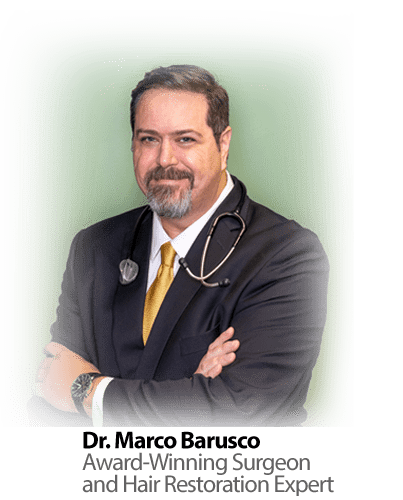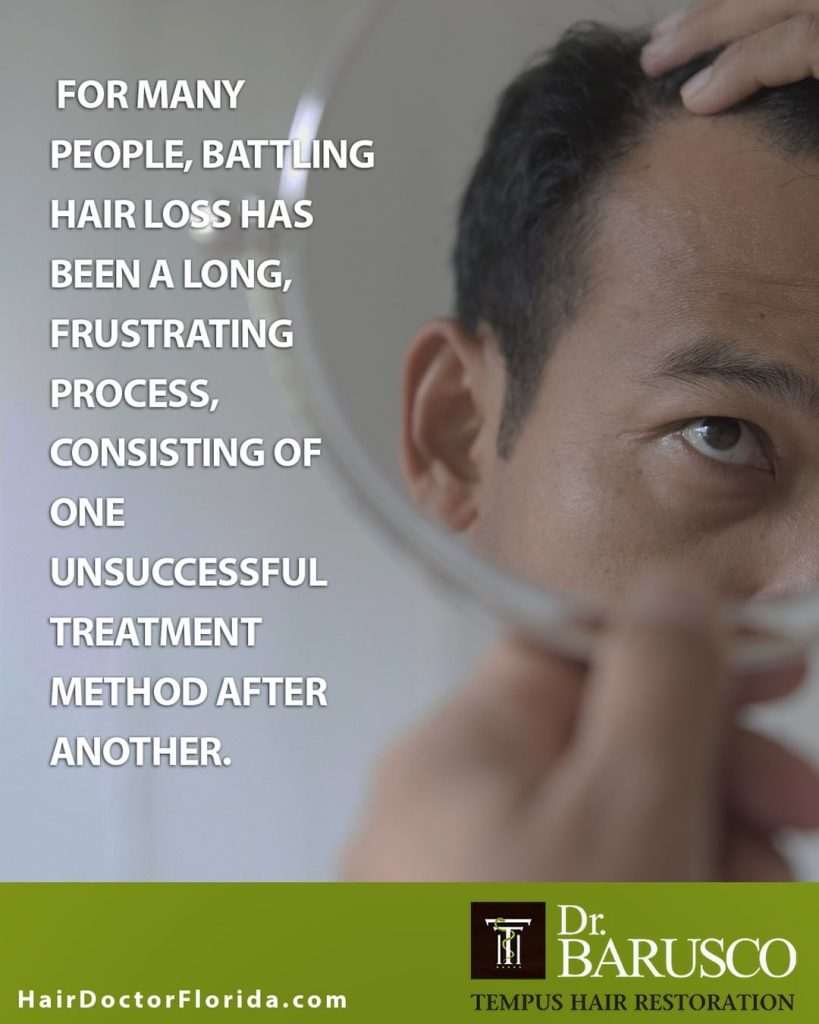Undergoing a hair transplant is an important decision. But if you choose the wrong doctor, the outcome of a bad hair transplant can be far worse than disappointing – it can be disfiguring and virtually impossible to hide. Disastrous results may range from over-harvested donor areas to unnatural growth patterns. For those who anticipated a fuller head of hair and a more youthful appearance, a bad hair transplant can have a profoundly negative effect on one’s self-image and self-esteem.
While such a devastating experience may leave one reluctant to undergo a corrective procedure, Dr. Marco Barusco – founder and Chief Medical Officer of Tempus Hair Restoration – has proven it is possible, in many cases, to mitigate the damage of bad hair transplants and achieve the look the patient had originally anticipated. First, however, we should look at why some hair transplants go wrong – as our July 2018 blog post covers.
Unfortunately, the main reasons are not improving. Many hair restoration practices market themselves primarily as providing an aesthetic service, rather than performing surgical procedures and acknowledging the serious responsibilities and risks involved. Unethical practices take advantage of their prospective patients’ lack of knowledge to mislead them into accepting situations and conditions that should not be at all acceptable – such as allowing technicians (not a doctor) to harvest hairs from the donor area and to create the incisions that will receive the harvested hairs.
The consensus of the many international professional societies dedicated to hair restoration surgery, the American Board of Hair Restoration Surgery and many State Medical Boards in the United States and abroad is that harvesting donor hair from a patient and creating incisions on the scalp to receive the harvested hairs are “non-delegable” phases of this complex procedure, and should only be done by a physician or adequately licensed professional.
The International Society of Hair Restoration Surgery (ISHRS) – of which Dr. Barusco is a committee member – is concerned about the growing risk to patients of technicians performing substantial aspects of hair restoration surgery.
The use of technicians to perform the aspects of hair restoration surgery that should only be performed by a properly trained and licensed physician, places patients at risk of misdiagnosis and mistreatment; failure to diagnose hair disorders and related systemic diseases; and performance of unnecessary or ill-advised surgery – all of which jeopardizes patient safety and outcomes.
An increasing number of hair restoration disasters are being reported by patients whose Follicular Unit Excision (FUE) procedure was botched by technicians using robotic surgery and other devices, the most widely known being the Neograft and the SmartGraft devices. The manufacturers of these devices recruit doctors with little to no experience in hair transplantation and sell them a machine that they don’t have to learn how to use – your entire procedure at these practices will be performed by technicians sent by the company.
Dr. Barusco has written an informative, insightful article about the widespread misuse of robotic technology in hair transplants. He relates his own experience in correcting the damage done to patients who had placed their trust (and money) in doctors who depend on these machines to perform the delicate procedures that only a highly skilled surgeon can.
Regardless of who you select to perform your hair restoration surgery (initial or corrective), taking a few minutes to read Dr. Barusco’s account will make you a better informed patient.
A key member of Dr. Barusco’s team is Jessica Aivazis, Patient Education Liaison. She has met at length with those seeking corrective treatment, and relates the experiences they’ve shared with her, as well as her own observations.
“Unfortunately, skill and technique are not uniform in this field, and we have seen many clients who have suffered poor results coming to Dr. Barusco for a solution. Unnatural results in the hair line and poor hair placement, and overharvesting of the donor site are the most common. We have even seen clients looking for assistance with infections they have developed at other offices.
“Each case is different, but Dr. Barusco makes it a point to meet with every client and attempt to assist them in gaining the results they originally expected. Due to his many years of experience and expertise, Dr. Barusco can provide a treatment plan most of the time. But it is heartbreaking when the situation is so bad that we cannot offer any help.”
Ms. Aivazis addresses the following questions regarding bad hair transplants.
Is there any type of badly performed procedure that’s particularly common?
“Due to the popularity of the Follicular Unit Excision (FUE) procedure, we have seen many patients who have suffered from overharvesting and detrimental scarring to their donor area. While this procedure is excellent – as it offers the patient the opportunity to have different hair styles – it must be done by a physician with experience and skill, as it has a higher chance of complications when not performed correctly.”
Why did these patients initially choose the doctor who botched the procedure? Was their decision based solely on cost, or were they uninformed, or both?
“Many times, cost was a driving factor for the clients who have had ‘botched’ results. During the consultation, we educate clients that skill and experience in hair transplantation and hair loss diagnosis should be the driving factors in choosing a physician. Here at Tempus, we offer many different financing options to make this an affordable decision, thus eliminating cost as a factor.”
Did anyone mention to you that they had some misgivings about their original doctor before and/or after the procedure? Was there a point at which they knew something was seriously wrong?
“Yes, many times clients feel in their gut that something isn’t right during the consultation, i.e. even before the procedure is done. There are many cases where clients don’t even meet their physician until the day of the procedure, or they don’t see the physician at all and notice that the technicians are performing the entire procedure themselves.”
I imagine that it is much more difficult to correct another doctor’s bad work than it is to start fresh, so to speak. How does Dr. Barusco plan corrective surgery in such cases, knowing that each situation is unique?

“Dr. Barusco meets with every client during the consultation, which I believe is pivotal in deciding the best treatment plan for the client. Once he develops the treatment plan, it is discussed with the client in length prior to scheduling. On the day of the procedure, Dr. Barusco takes as much time as needed to make sure that the patient understands and agrees with the treatment plan before proceeding. I have seen Dr. Barusco cancel procedures in the morning they were going to take place, because he did not feel that the patient was ready and/or had a good understanding of both the short- and long-term implications of his or her decisions. This gives a hands-on approach in tackling every client’s unique case.”
What kind of credentials should a surgeon who does corrective work have?
“The surgeon should have experience in hair restoration, and it should be their specialty. Add to that a background in surgery, good cosmetic sense and a team that has been with the physician for years, and you have a great combination.”
Can you provide examples of patients (anonymously, of course) who saw a major improvement after Dr. Barusco corrected their bad transplant?
 “I know many clients who have seen major improvements by Dr. Barusco’s hands. However, the two that stand out to me are the following.
“I know many clients who have seen major improvements by Dr. Barusco’s hands. However, the two that stand out to me are the following.
“A gentleman had a couple of procedures done by a doctor via FUT (or strip method). Typically when an FUT procedure is done and a client comes in to have another procedure (whether it be for density purposes or to assist with further loss), the physician will utilize the same scar line on the client so they do not have multiple scars. However, this was not the case for this gentleman, who was left with multiple unsightly scars on the back of his head.
“Dr. Barusco was able to assist the client with scar revisions and hair into the scar area in order to limit the client to one scar. Unfortunately, his donor area was affected due to the multiple scarred areas, and the chance of having another procedure to add density is no longer there unless the patient undergoes hair clone therapy, which is under development.
“There is also a female client who comes to mind who had a procedure elsewhere and was left with an unnatural hair line that was extremely evident to all who looked at her. She had a hard time styling her hair, and the punches done were large and unsightly. Dr. Barusco was able to soften her hair line with one procedure to give her a more delicate, feminine look. Her hair is now better able to be attractively styled, and she has more confidence.”
What advice can you give people who are considering a hair transplant to ensure they get the best restoration procedure?
“The best advice I can give is to know your surgeon, do your research and ask questions. A well-informed client is important to ensure a decision like this can be made confidently.”
Patients should ask the following questions:
- Who will evaluate my hair loss and recommend a course of treatment? What is their education, training, licensure, and experience in treating hair loss? Only physicians, Physician’s Assistants and Nurse Practitioners are legally allowed to diagnose a patient and to recommend medical treatments. Otherwise, the person recommending procedures and/or treatments is practicing medicine without a license, a Felony crime in Florida and many states.
- Who will be involved in performing my surgery, what role will they play, and what is their education, training, licensure, and experience performing hair restoration surgery?
- Will anyone not allowed by the State Medical Board be making incisions or harvesting grafts during my surgery? If so, please identify this person, explain their specific role and why they are legally permitted to perform it.
- Is everyone involved in my surgery covered by malpractice insurance?
Once you are at the consultation, make sure all of your questions are answered to your satisfaction and DEMAND TO SEE A PHYSICIAN. At Tempus Hair Restoration, every prospective patient meets with Dr. Barusco – whether the consultation is in-office, or by video conference.
Throughout the time a patient is under Dr. Barusco’s care, Ms. Aivazis guides each patient, educating them on the technique(s) that will be implemented during their treatment. She spends as much time as needed to ensure that patients understand what they can expect, as well as to provide instructions and explanations on post-surgery care. Besides, all patients have direct access to Dr. Barusco’s cell phone, so they have an open line of communication with him if needed.
Choose your surgeon carefully based on experience, results and integrity. Dr. Barusco’s long list of accomplishments, his notable artistic ability and his successful surgical team make Tempus Hair Restoration a renowned practice.
Dr. Barusco also conducts virtual consultations for those who can’t travel to one of our 14 Florida locations, and our office will arrange travel and accommodations for out-of-area patients. We invite you to learn more about our procedures, then contact us to schedule your free consultation with Dr. Barusco. We look forward to meeting you and discussing your options.

